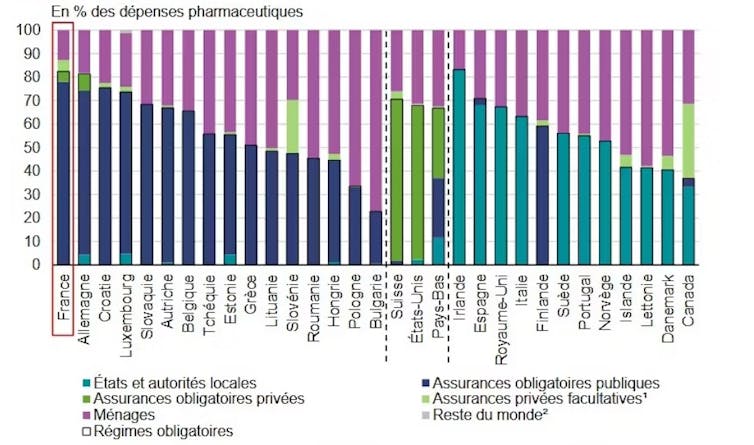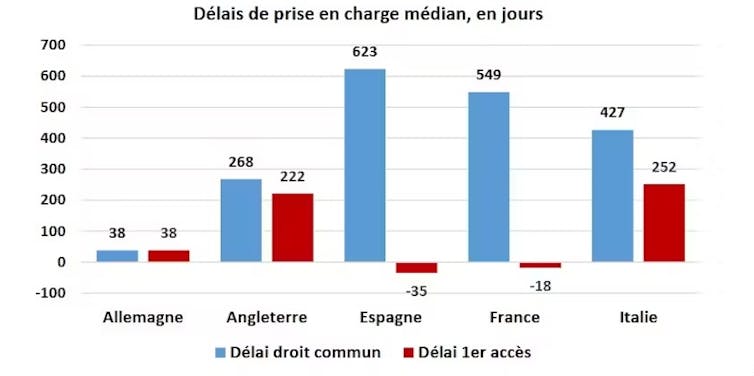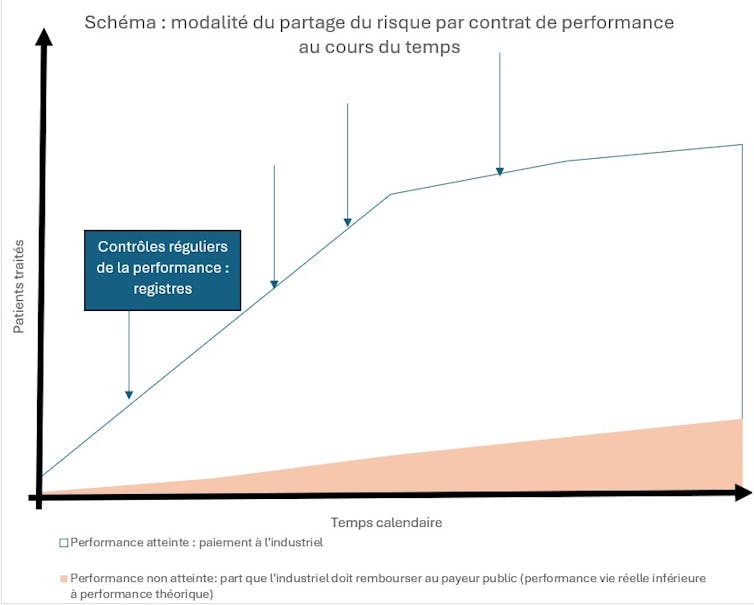Innovative medicines: France faces Trump's price war
Faced with Donald Trump's tariffs, French public policymakers are trying to solve a complex equation. How do you encourage public and private organizations to create innovative medicines that meet unmet therapeutic needs, within a constrained budgetary framework, and do so quickly and fairly? Mission impossible?
Augustin Rigollot, University of Montpellier

On May 12, 2025, Donald Trump announced an executive order to lower drug prices in the United States, accusing other countries of taking advantage of excessively advantageous prices. On August 4, he issued an ultimatum to this effect to 17 major pharmaceutical companies.
In France and Europe, this has led to fears of higher drug prices, particularly for new molecules that address unmet therapeutic needs. As the US pharmaceutical market is the largest in the world, a price drop in the world's leading economy will symmetrically lead to a price rise in other countries. In the United States, prices are negotiated mainly between pharmaceutical companies and private insurers, with limited government intervention, resulting in particularly high prices. In Europe, on the other hand, prices are generally lower, as they are negotiated by the public payer, with strong state power. Now, the Trump administration wants the United States to systematically benefit from the lowest price among those found in other countries. This leaves laboratories with only two choices:
- bring prices in the United States down to the level of the lowest prices, particularly in the European Union (EU), with drug manufacturers suffering a heavy loss of income on a global scale, hampering their ability to invest in innovation;
- increase drug prices in EU countries and elsewhere in the world, bringing them into line with US prices, in order to preserve their global margins and limit the decline in their US revenues.
All in all, the countries currently benefiting from the highest discounts will be the hardest hit by any increases, and the overall price of therapeutic innovation will rise: a risk for its accessibility.
This news highlights the different healthcare models in the world, between public insurance financing, as in France, and private insurance financing, as in the United States. So what leverage does France have in the face of rising prices for innovative drugs? What about cancer drugs in particular (oncology)?
Low drug prices in France
France benefits from effective medico-economic price negotiation. As a result, prices are much lower in France thanon the other side of the Atlantic, exposing our country to the risk of price rises. There is a historical reason for this: France represents a large volume of drug sales in Europe, solvent thanks to compulsory public insurance. De facto, the outlet is guaranteed for manufacturers, an argument for negotiating lower prices.
France has a regulatory environment that restricts pricing. Low prices in our country mean that out-of-pocket expenses are kept to a minimum, ranking among the lowest in Europe.

However, France is facing increasing budget constraints, as illustrated by the 5 billion euros in savings forecast in the 2026 social accounts. Its room for maneuver in the face of an increase in the price of innovation would therefore be particularly limited.
Accessibility of medicines
France has lower accessibility to pharmaceutical innovation than its European neighbors 63% of new drugs are available in France, compared with 88% in Germany. For example, in oncology (cancer diagnosis and treatment), France ranks 6ᵉ in terms of availability in Europe in 2020. To explain this lack of accessibility, manufacturers point to shortcomings in the French drug market. Among the obstacles to accessibility, the French Pharmaceutical Industries Association (LEEM) points to the excessively low price of medicines in France, which is said to be unattractive compared to comparable European countries. This lack of attractiveness is not limited to price, and is reinforced by excessively long access times to the French market, particularly in comparison with Germany. This context does not encourage manufacturers to prioritize the French market for their launches.
The early access procedure goes a long way towards mitigating the delay in access.

Thanks to this derogatory procedure, a presumably innovative drug that meets a major and serious medical need is reimbursed on the market without having to wait for the end of the marketing authorization (MA) procedure. This has led to a drastic reduction in access times for over 120,000 patients in France, involving around a hundred costly and innovative molecules, especially in oncology.
Reasons for concern
Another concern, that of solidarity, reflects the expectations of the public payer. It is illustrated by opinion 135 of the French National Consultative Ethics Committee (CCNE) in 2021. The latter is concerned about the sustainability of our social model.
"The very high prices of certain innovative treatments could compromise the financial equilibrium of healthcare systems as they currently operate."
Since this opinion, the reasons for concern have increased in parallel with the rise in innovation prices. The world's most expensive drug, Libmeldy (treatment of metachromatic leukodystrophy), now costs 2.5 million euros in Europe, and around 4.25 million dollars in the United States.
Risk-sharing contracts
Among the many mechanisms available to us, some enable us to control price and market access at a very early stage in the negotiation process, while supporting high-performance innovations. These include risk-sharing agreements. They have been documented for some fifteen years, and will be included, for example, in Article 54 of the French Social Security Financing Bill (PLFSS) in 2023 for advanced therapy drugs (MTIs). These agreements between a pharmaceutical company and the public payer are designed to limit the financial consequences of new treatments.
These contracts are not yet widely used in France. They constitute a pool of efficiency that public policies could use in the event of inflation in the price of therapeutic innovation, against the backdrop of a tariff war coming from Donald Trump's United States.

We distinguish :
- Financial-based agreements are the most common. They cap expenditure, with volume thresholds (price-volume agreements) beyond which the manufacturer reduces its price to stabilize the budget. In exchange, the public payer guarantees volumes and improved market access.
- Performance-based risk-sharing agreements, which index payment to the actual performance of the drug, rather than just the results of clinical trials. They are based on clinical efficiency criteria, with clauses for total or partial reimbursement by the manufacturer in the event of insufficient real-life results. These contracts are ideally suited to drugs with a restricted target population (so that real-life performance can be properly monitored), or for which uncertainty about real-life efficacy is high at the time of marketing.
The Italian example in oncology
Italy is often considered the most advanced European country in risk-sharing agreements, particularly in oncology. In 2017, the amount saved via these contracts was estimated at nearly half a billion euros (35 million on performance contracts alone). In oncology, the time to market for molecules covered by these agreements is estimated to have been reduced by 256 days.
This deployment in Italy was accompanied early on by a sophisticated system for collecting and evaluating real-life performance data, managed by the Italian Public Health Agency (AIFA). In 2016, it already had 172 real-life data registers covering more than 300 risk-sharing contracts, involving around 900,000 patients. The additional cost of this monitoring was estimated at between €30,0000 and €60,000 per drug per year in the first year, decreasing thereafter. The question of sharing this cost between the public payer and the manufacturer also needs to be considered.
France lacks such a logical approach to collecting real-life performance data. This partly explains our lag and the low number of performance contracts - around fifteen in ten years, according to health economist Gérard de Pouvourville.
Today, the challenge remains to develop these contracts without performance monitoring monopolizing healthcare resources in a context of shortage of time and medical resources.
Solidarity put to the test
The problem of balancing support for innovation, its accessibility and the sustainability of the healthcare system is not just a French issue. It is such an important issue that it has been incorporated into the Pharmaceutical Strategy for Europe 2020. The European Hi-Prix project is seeking a response to this issue, with the creation of the Pay for Innovation Observatory, which provides an online inventory of all innovation financing schemes.
Faced with the inflation in the price of innovative drugs, which is out of all proportion to their sustainability for healthcare systems, an ethical debate is also emerging, which cannot be resolved by economic predictions alone.
If the price of innovation, particularly for orphan or rare diseases, continues to rise, and if, at the same time, diagnostic advances, notably in gene technology, remove theuncertainty about the hazards and future states of health of individuals, there is a risk of undermining the willingness to pay that forms the basis of the tacit contract of insurance solidarity in our societies.
Augustin Rigollot, economics and philosophy graduate, specialized in health economics (UPEC), medical student in 6th year, University of Montpellier
This article is republished from The Conversation under a Creative Commons license. Read theoriginal article.